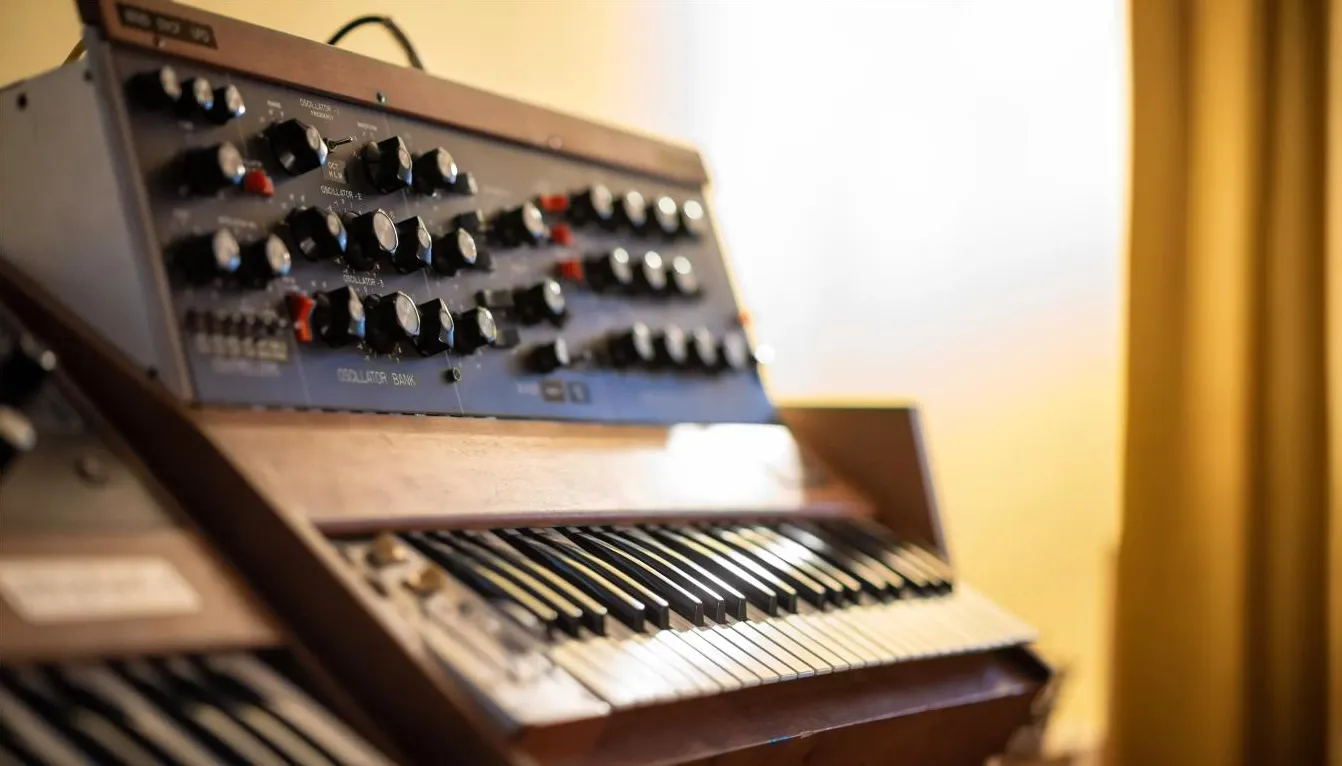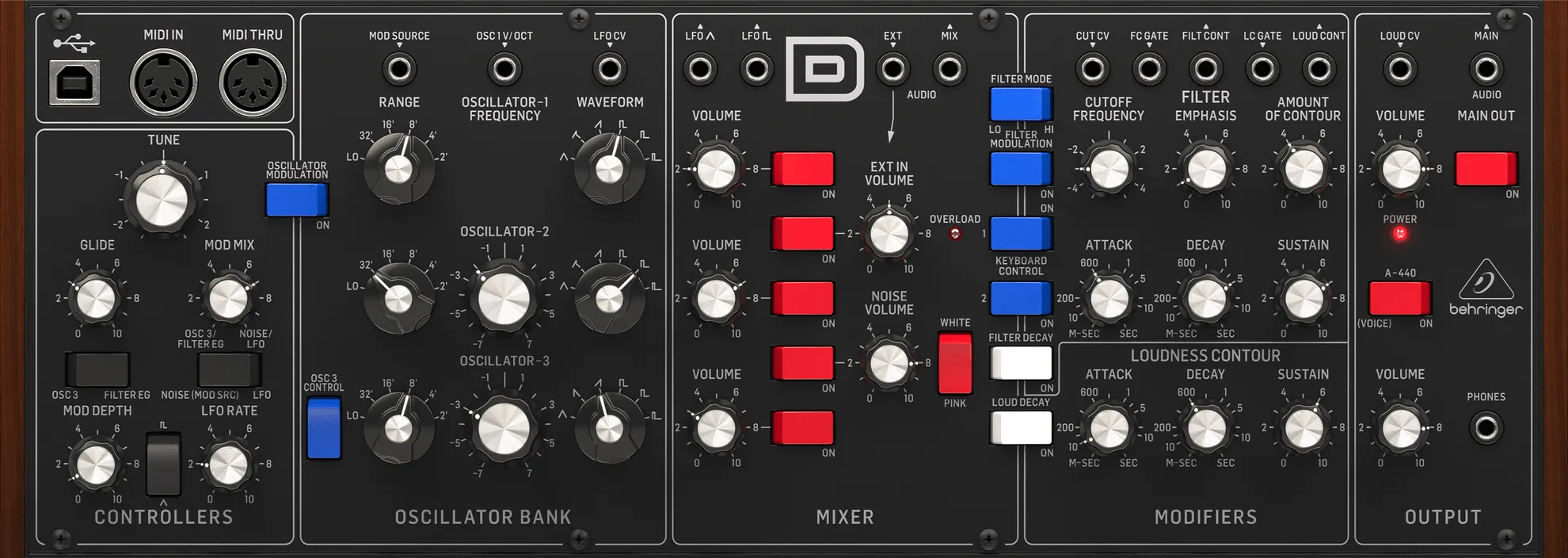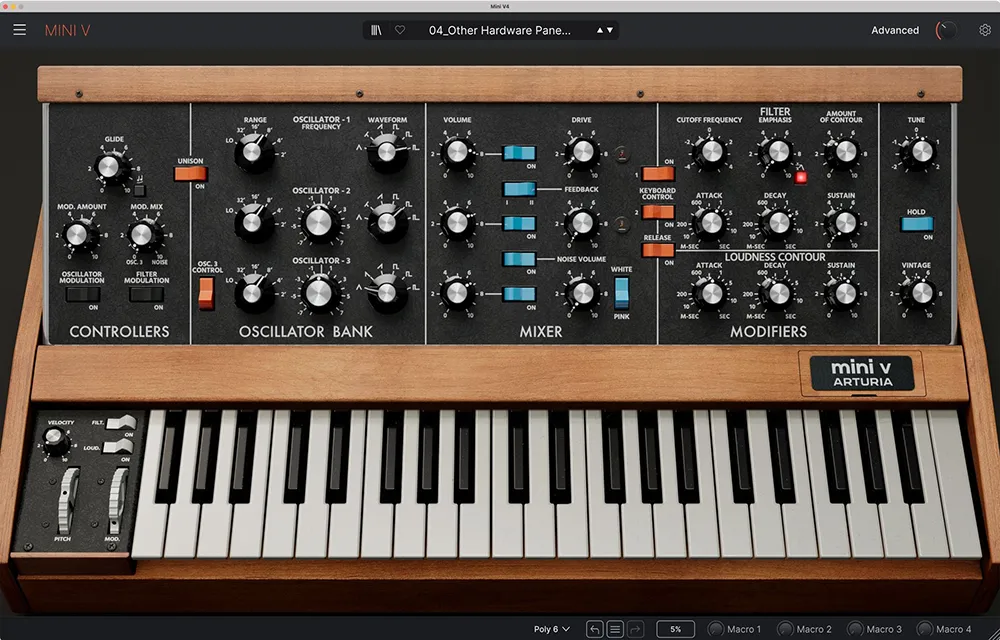Moog Minimoog: History, Versions & Best VST Emulations

Moog Minimoog is a legendary synthesizer that has shaped the sound of electronic music since its debut in the 1970s. Known for its warm analog tones and user-friendly design, the Minimoog has had a profound impact on genres like techno and electronic music. In this guide, we’ll explore the history of the Moog Minimoog, review its different versions, share tips on how to use it effectively, and highlight the best hardware clones and paid VST emulations available today.
The Moog Minimoog was released by Moog Music in 1970 as a compact and portable alternative to large modular synthesizers. Designed by Bill Hemsath and Robert Moog, it was the first synthesizer to combine a keyboard with modular-like architecture, making it accessible to both musicians and producers.
The most popular version, the Minimoog Model D, gained fame for its rich analog sound and intuitive interface. It quickly became a staple in the studios of artists like Keith Emerson, Rick Wakeman, Flavio Premoli of PFM, Herbie Hancock, Gary Numan and Kraftwerk, helping to define the sound of electronic music. Despite production ending in 1981, the Minimoog’s legacy continued, leading Moog Music to reissue the Model D in 2016 and again in a modern version with updated features.
Versions
- Minimoog Model A to C: These were the initial prototypes with limited production runs, used mainly for testing and development feedback.
- Minimoog Model D: The most famous and widely used version, known for its three oscillators, noise generator, and the iconic Moog Ladder Filter, which provides its signature sound.
- Minimoog Voyager: Released in 2002, the Voyager was a modern reinterpretation of the Minimoog, featuring patch memory, MIDI, and additional modulation options, all while retaining the core analog sound.
- Minimoog Voyager Rack: A compact, rack-mounted version of the Voyager that delivers the same powerful analog sound in a space-saving format. It’s an excellent choice for studio setups, offering full MIDI control and integration while maintaining the core sonic characteristics of the Voyager series.
- Moog Voyager Old School: Introduced in 2008, this version of the Voyager removed patch memory and MIDI functionality, focusing on a fully analog signal path and a streamlined, vintage-inspired design. It’s favored by purists who appreciate the tactile experience and classic workflow of the original Minimoog.
- Current Minimoog Model D (2016): This reissue marked the return of the classic Minimoog Model D after 35 years. It stayed faithful to the original design, featuring hand-assembled analog circuits and the same rich sound. Modern additions included MIDI connectivity, a dedicated LFO, and improved modulation capabilities, making it suitable for contemporary workflows while preserving its vintage essence.
- Current Minimoog Model D (2022): The 2022 version further enhanced the reissue with updated components for improved durability and stability. While retaining the analog sound and design of the original, this version also introduced features like velocity sensitivity and aftertouch for greater expression. Moog Music emphasized modern reliability, ensuring that this iteration meets the demands of today’s musicians and producers.
How to Use This Synth in Your Music
The Moog Minimoog is praised for its powerful sound design, offering punchy basslines and soaring leads with its three oscillators, noise generator, and classic Ladder Filter
Key Tips for Using the Moog Minimoog Effectively:
- Oscillators: Experiment with different waveforms (saw, square, triangle) and tuning to create harmonically rich sounds. Slight detuning of the oscillators can add warmth and depth to your patches.
- Filter: The Ladder Filter is key to shaping the Moog Minimoog’s sound. Adjust the cutoff and resonance to sculpt your tones, and use filter sweeps to add movement to your tracks.
- Noise Generator: Use the noise generator to create textured effects by combining it with high resonance and gradual filter sweeps. This technique can add tension and dynamic shifts to your sound, perfect for intros, buildups, or experimental layers in your tracks.
- Envelopes: Use the Attack, Decay, and Sustain controls to shape your sound’s dynamics. Quick attacks work well for sharp, punchy sounds, while longer decays and sustains can create lush, evolving textures.
- Modulation: Utilize the LFO (low-frequency oscillator) for vibrato, tremolo, or rhythmic modulation. Syncing the LFO to your track’s tempo can create rhythmic effects that enhance the overall feel of your music.
The Moog Minimoog in Techno and Electronic Music
The Moog Minimoog is a staple in techno and electronic music due to its thick, analog basses and powerful leads. Furthermore, artists such as Kraftwerk, Daft Punk, and Carl Craig have harnessed the Minimoog’s distinctive sound in their productions, frequently using it for resonant basslines or cutting leads that stand out in a mix.
Tips for Getting the Best Sound from the Moog Minimoog
- Layer Oscillators: Layering the Moog Minimoog’s oscillators with slight detuning can produce a thick, chorus-like effect that adds richness and depth to your sound.
- Explore Filter Modulation: Automate the filter cutoff to add dynamic movement to your sounds, creating evolving textures that keep your tracks interesting.
- Use External Overdrive: Running the Moog through an overdrive or distortion unit can add extra grit and character, making it perfect for more aggressive styles of electronic music.
- Expand with External Effects: While the Moog does not have built-in effects, adding reverb, delay, or chorus externally can greatly expand its sonic range.
Best Clones and Hardware alternatives

For those who want the Moog experience without the vintage price, there are several high-quality hardware clones available:
- Current Minimoog Model D: The latest version from Moog Music faithfully reproduces the original’s sound and feel, with modern updates suitable for today’s musicians.
- Behringer Poly D: An expanded version of the Model D clone, the Poly D offers polyphony with up to four voices, a built-in sequencer, effects like chorus and distortion, and an extended keyboard. This makes it a versatile and accessible option for both classic and modern sounds.
- Behringer Model D: A budget-friendly clone that closely replicates the original Model D sound, featuring modern enhancements like MIDI and USB connectivity.
- Studio Electronics SE-02: A rack-mounted version with additional modulation options, MIDI integration, and patch memory, making it a versatile tool in the studio.
- Studio Electronics MIDImini V3: A modern reinterpretation of the original MIDImini, the V3 combines the rich, analog circuitry inspired by the Minimoog with enhanced features like MIDI integration and preset recall. This desktop module delivers the authentic Minimoog sound in a compact and professional package.
Best VST Emulations

To bring the Moog Minimoog sound into your digital setup, consider these top-tier paid VST plugins:
- Arturia Mini V: Known for its authentic emulation and added features like polyphony, effects, and advanced modulation options.
- UAD Moog Minimoog: Offers a highly detailed emulation that captures the warmth and character of the original hardware, making it a favorite among producers.
- Softube Model 72: A meticulous analog modeling plugin that captures the nuances of the Moog Model D, with additional features for modern production needs. It also offers modular compatibility, with all Model 72 instrument sections available as individual modules for Softube Modular. These modules can be integrated into your Eurorack system, allowing you to combine parts of the synthesizer in a modular workflow to build patches and achieve authentic vintage monophonic sounds.
- Cherry Audio Miniverse: A faithful and affordable VST emulation of the Moog, offering a user-friendly interface and expanded modulation options.
- Synapse Audio The Legend HZ: Renowned for its detailed sound modeling and rich analog character, this plugin closely mimics the Moog Minimoog’s sonic qualities.
- U-he Diva: Diva includes Minimoog-inspired modules within a versatile analog modeling environment, making it a powerful tool in any producer’s arsenal.
- Native Instruments Monark: Uses advanced modeling to recreate the distinctive Moog sound, making it a popular choice for electronic music producers.
- Moog Minimoog Model D App: Developed by Moog, this app provides a highly authentic Minimoog experience on your DAW or mobile device, featuring the same sound engine as the hardware.
- GeForce Minimonsta 2: Combines the classic Moog sound with modern enhancements like additional modulation capabilities, polyphony, and patch memory.
Conclusion
The Moog Minimoog remains an essential tool for music producers, offering a timeless sound that continues to inspire. Whether you’re using a vintage Model D, a modern hardware clone, or a paid VST emulation, the Minimoog’s distinctive analog tones are within reach. By exploring its history, mastering its controls, and choosing the right version or emulation, you can unlock the full potential of this iconic synthesizer in your music productions.
For more Moog-inspired sounds, check out the preset banks available on UltimatePreset.com. Explore our collection of presets designed to capture the essence of classic Moog tones and elevate your music production.
